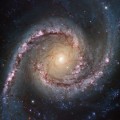by Ann » Wed Jul 06, 2016 6:42 am
It's good to see such a deep and detailed image of a trio of galaxies that don't often get their portrait taken.
Huge NGC 5566 has a very interesting shape. It sports two long, rather thin, sweeping, very elegant dusty arms that contain some star formation. The lower arm seems to emanate from the blue ring - the bluest part of the galaxy - but I think that the seeming connection is an illusion. Just below the ring the lower arm displays a fantastic "pearls-on-a-string" lineup of more than ten pink nebulas and blue clusters.

The shape of the arms creates what looks like a closed figure eight, although at lower right streamers of material escape from the main disk of the galaxy at right angles. Inside the arms, the disk is filled with a diffuse, pale glow. It would seem that most of the disk is made up of an old to intermediate population of stars. Overall, NGC 5566 appears to be a quite red galaxy, heavily dominated by old to intermediate stars. The amount of dust in NGC 5566 is rather small.
Fascinatingly, the "upper part" of the disk of NGC 5566 contains some brilliantly orange objects. At least one of these objects is clearly elongated, so that it must be a background galaxy. But the brightest orange object looks like one member of an arc of differently colored objects, as if a reddened background galaxy had insinuated itself right between two similarly-sized blue clusters in NGC 5566. It looks strange. Most of the background of today's APOD lacks saturated orange objects altogether. Today's APOD must be a composite object.

NGC 1566.
The small satellite galaxy of NGC 5566, NGC 5569, looks bluish mostly because it lacks a bright yellow population. It is actually shaped like a faint Sc galaxy, with incipient arms at right and left. Its shape is actually somewhat reminiscent of bright, beautiful
NGC 1566, although NGC 5569 is many times fainter and less organized, with faint arms mostly lacking in star formation. Pink nebulas and blue clusters in NGC 5569 are faint and mostly scattered, although a curving line of nebulas and clusters trace out a lovely arc shape.

Integral sign galaxy, UGC 3697.
The third galaxy, elongated, slightly S-shaped NGC 5560, is clearly affected by tidal forces. Out of the three galaxies here, NGC 5560 may contain the largest blue population. We can clearly see the thin and the thick disk of NGC 5560: the thin disk is mostly blue and dusty, whereas the thick disk is diffuse and neutral-colored. A diffuse halo of stars can be seen above and below the bright yellow center of the galaxy.
This is a fascinating image! Thanks!
Ann
It's good to see such a deep and detailed image of a trio of galaxies that don't often get their portrait taken.
Huge NGC 5566 has a very interesting shape. It sports two long, rather thin, sweeping, very elegant dusty arms that contain some star formation. The lower arm seems to emanate from the blue ring - the bluest part of the galaxy - but I think that the seeming connection is an illusion. Just below the ring the lower arm displays a fantastic "pearls-on-a-string" lineup of more than ten pink nebulas and blue clusters.
[img]http://mathworld.wolfram.com/images/eps-gif/FigureEight_1000.gif[/img]The shape of the arms creates what looks like a closed figure eight, although at lower right streamers of material escape from the main disk of the galaxy at right angles. Inside the arms, the disk is filled with a diffuse, pale glow. It would seem that most of the disk is made up of an old to intermediate population of stars. Overall, NGC 5566 appears to be a quite red galaxy, heavily dominated by old to intermediate stars. The amount of dust in NGC 5566 is rather small.
Fascinatingly, the "upper part" of the disk of NGC 5566 contains some brilliantly orange objects. At least one of these objects is clearly elongated, so that it must be a background galaxy. But the brightest orange object looks like one member of an arc of differently colored objects, as if a reddened background galaxy had insinuated itself right between two similarly-sized blue clusters in NGC 5566. It looks strange. Most of the background of today's APOD lacks saturated orange objects altogether. Today's APOD must be a composite object.
[float=left][img]http://scitechdaily.com/images/New-Hubble-Image-of-Intermediate-Spiral-Galaxy-NGC-1566-120x120.jpg[/img][c][size=75]NGC 1566.[/size][/float][/c]The small satellite galaxy of NGC 5566, NGC 5569, looks bluish mostly because it lacks a bright yellow population. It is actually shaped like a faint Sc galaxy, with incipient arms at right and left. Its shape is actually somewhat reminiscent of bright, beautiful [url=https://upload.wikimedia.org/wikipedia/commons/thumb/1/13/Grand_Swirls_NGC_1566.jpg/220px-Grand_Swirls_NGC_1566.jpg]NGC 1566[/url], although NGC 5569 is many times fainter and less organized, with faint arms mostly lacking in star formation. Pink nebulas and blue clusters in NGC 5569 are faint and mostly scattered, although a curving line of nebulas and clusters trace out a lovely arc shape.
[float=right][img]http://tinyurl.com/z4yve3c[/img][c][size=75]Integral sign galaxy, UGC 3697.[/size][/c][/float]The third galaxy, elongated, slightly S-shaped NGC 5560, is clearly affected by tidal forces. Out of the three galaxies here, NGC 5560 may contain the largest blue population. We can clearly see the thin and the thick disk of NGC 5560: the thin disk is mostly blue and dusty, whereas the thick disk is diffuse and neutral-colored. A diffuse halo of stars can be seen above and below the bright yellow center of the galaxy.
This is a fascinating image! Thanks!
Ann